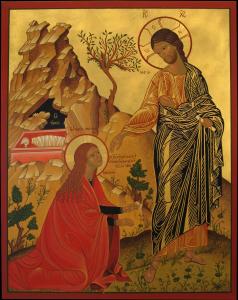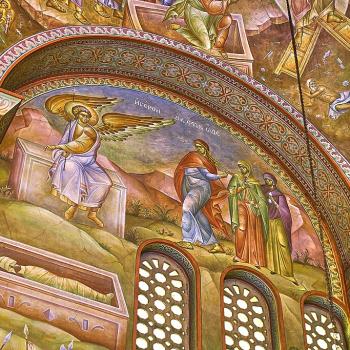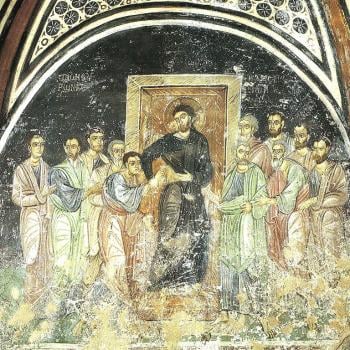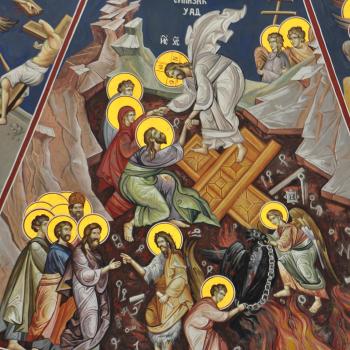
According to tradition, but not mentioned in Scripture, the first person to witness the resurrected Christ was his mother, Mary. This, at first, seems odd; why would it not be mentioned in Scripture if it happened? Yet, we know that all that Jesus said and did was not presented in Scripture. Indeed, as the writer of John indicated, it would be nearly impossible to do so (cf. Jn. 21:25). The early Christians knew things which were written down. Indeed, their faith came from their own experiences. Scripture came later. It was meant to help keep a few things preserved in the church’s universal memory and to show their theological significance when necessary. Paul wrote letters to deal with various crises, explaining things when there was some controversy, being silent on those things which he thought everyone already knew and understood (which is why arguments based solely upon the silence of Paul tend to lead to all kinds of erroneous conclusions). Thus, whether or not she was the first to encounter the risen Christ, it does not need to be in Scripture for it to be something which was held and believed and understood by Christians. But it still seems odd for it not to be mentioned by any Gospel writer. St. Maximos the Confessor, reflecting on this, thought that the Gospel writers might have been concerned with the reaction non-Christians might have had if this was recorded in Scripture: they would wonder if the resurrection was a scam invented and perpetuated by Mary:
Even though the evangelists mentioned none of this in the account of the Resurrection, it is for this reason they left out the mother’s witness: to preclude any doubt and so that no one would take it as reason for disbelief that the vision of the Resurrection was reported by the mother.[1]
Since Scripture does not report the Theotokos was a witness of the resurrection, people can believe or disbelieve the tradition as they want. It is not fundamental to the faith. But it is an interesting tradition. It is based upon the notion that Mary stayed beside Christ and would not leave his side, even in his death, so that she and she alone could be there when the resurrection took place. The tradition makes sense, especially as we know of Mary’s special relationship with Christ, though the argument as to why it was not included in one of the Gospels is a little weak – certainly some could have suggested Mary made it up, but then again, that argument has also been made about those witnesses given to us by the Gospels, and that has not stopped their testimony from being written down. Perhaps, because the resurrection is mysterious – indeed, it is one of the greatest mysteries of the faith — reporting Mary’s witness of the event itself, if she were there, could have taken a little of that mystery away and led many to think of the resurrection as a mere resuscitation, for what could have been described would have been less than the reality of the event itself. The silence of Mary, just like the silence of the original ending of Mark of what happened after the resurrection, serves as a reminder of the great mystery which lies behind the event itself.
Whether or not Jesus’ mother was first to witness his resurrection, the first witnesses were women, and they were called to spread what they had learned and experienced to the rest of Jesus’ disciples. The Gospel writers give us a few different accounts of the way the women encountered the risen Jesus, but central to all of them was the way he appeared to St. Mary Magdalene:
Now when he rose early on the first day of the week, he appeared first to Mary Magdalene, from whom he had cast out seven demons. She went and told those who had been with him, as they mourned and wept. But when they heard that he was alive and had been seen by her, they would not believe it (Mk. 16:9-11 RSV).
Mary and the other women were not believed. Jesus had sent them out to be the first preachers of the resurrection, and they were not believed. Jesus’ disciples, especially his chief eleven disciples, the apostles, should have known the women and their honesty. The eleven should have believed the women, but they did not. When Jesus met with the eleven, we are told he was not pleased. “Afterward he appeared to the eleven themselves as they sat at table; and he upbraided them for their unbelief and hardness of heart, because they had not believed those who saw him after he had risen” (Mk. 16:14 RSV).
Women throughout history know what it is to be disbelieved. They know what it is to be ignored, to have their truth rejected, because what they have to say is shocking, if not inconvenient, to those in power. By choosing women to be the first to proclaim the resurrection from the dead, by choosing women to be his first witnesses to the world, Jesus shows us that we should not treat women in this way. We should respect them and what they have to say. We should trust them and believe them. As the resurrection restores all things, overcoming the corruption of sin and the social constructs which emerged as a result of sin, so we see Christ overcoming the social placement of women in the first century by having them become the first true evangelists.
It is possible that the eleven thought Jesus would choose them to be his first witnesses, to continue on with the social construct of the day, and so their doubt came, not only from the fact that the resurrection was a shocking, world-changing event, but also because Jesus transcended and so denied the social construct which they wanted to hold onto; if so, then it was their attachment to that construct, more than anything else, which caused them to stumble and not believe. Jesus properly upbraided them for their lack of belief, not only because of all that he had said and done should have given them reason to accept his resurrection from the dead, but also during his own earthly ministry he had consistently criticized and overturned the social construct which they still upheld: was that not, for example what they had seen and witnessed when Jesus talked with St. Photina? Had he not already indicated how the special devotion and love of St. Mary Magdalene made her transcend the external piety and devotion promoted by the social construct of their day, a construct represented by her sister, Martha? Clearly, they had not paid attention. They had not learned what they should have learned. They were still stuck in social conventions, as Martha had been, and so the greater path of Mary Magdalene, the path which transcended all such conventions, was ignored. The eleven were not ready to listen to and acknowledge the place of the women and the status they had been given by Christ. Truly, this is a problem Christians have had since the very beginning, and is a problem which remains with us today.
To be sure, it was not just the social construct which oppressed women which Jesus overturns in the resurrection, it is all unjust social constructs which Jesus transcends and would have us transcend. It is a problem which we all have to face and experience as we deal with systematic sin. It is a problem which we have to confront, again and again, in church history, so that, if we look to the Acts of the Apostles, we learn there was no perfect idealized time for Christians. Thus, we find how Christians were separating themselves into those who were classified as “Hellenists” and those who were classified as “Hebrews.” This was a social construct which was used by the “Hebrews” to hinder and undermine the “Hellenists” This caused a scandal in the church, the solution of which was the establishment of the order of deacons, so that the deacons were meant to serve the church making sure all the faithful were equally treated and respected, having their spiritual and material needs met:
Now in these days when the disciples were increasing in number, the Hellenists murmured against the Hebrews because their widows were neglected in the daily distribution. And the twelve summoned the body of the disciples and said, “It is not right that we should give up preaching the word of God to serve tables. Therefore, brethren, pick out from among you seven men of good repute, full of the Spirit and of wisdom, whom we may appoint to this duty. But we will devote ourselves to prayer and to the ministry of the word.” And what they said pleased the whole multitude, and they chose Stephen, a man full of faith and of the Holy Spirit, and Philip, and Prochorus, and Nicanor, and Timon, and Parmenas, and Nicolaus, a proselyte of Antioch. These they set before the apostles, and they prayed and laid their hands upon them. And the word of God increased; and the number of the disciples multiplied greatly in Jerusalem, and a great many of the priests were obedient to the faith (Acts 6:1-7 RSV).
Obviously, as history shows, the establishment of the deacons helped, but the social construct remained, and even the apostles found themselves falling for it, which is why Paul had to admonish Peter when Peter acted out of that construct and started ignoring the Gentile converts (cf. Gal. 2:11-14). Whenever Christians take the resurrection to heart, they begin to transcend social conventions and reach out to those who have been hurt by them; then, in their metanoia and the transformation of their actions, the grace of God is spread far and wide. So long as social conventions are used to ignore, or worse, hinder some people, the Gospel itself is hindered, and those who should have been welcomed and treated with love are turned away. This is why systematic racism, which is a sin which causes unjust divisions due to social constructs, has no place in the church and in the heart of Christians. Likewise, misogyny, based upon its own social construct, must be denied. In overcoming all such constructs, the glory of the resurrection shines, allowing for grace to be spread throughout all creation.
[1] St. Maximus the Confessor, The Life of the Virgin. Trans. Stephen J. Shoemaker (New Haven, CT: Yale University Press, 2012), 119-20.
Stay in touch! Like A Little Bit of Nothing on Facebook.
If you liked what you read, please consider sharing it with your friends and family!












